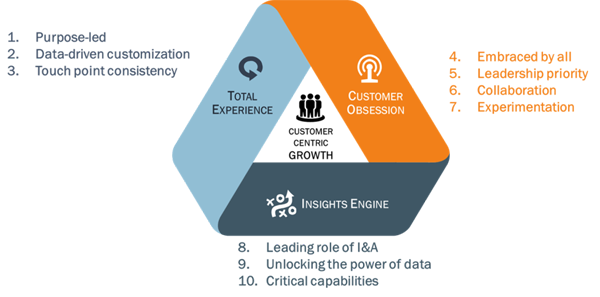Insights2020: Three dimensions for customer-centric growth
It’s difficult to imagine the possibilities for the ocean of behavioural data these devices will provide. It means we will (finally) have the data available to better understand people and what they want – and to reshape our brands and business to become truly customer-centric. Being customer-centric is key in the current environment, where traditional value drivers such as product quality or a strong distribution network don’t cut it anymore. Anyone can produce quality products, manufacturing no longer provides a sustainable competitive advantage, and with channels widely available and used by all (both online and offline) the distribution network hardly provides a competitive advantage. Thus, the true source of competitive advantage lies in understanding the needs of customers and serving them in a fast, transparent and credible way: being customer-centric. Put simply, creating a customer-centric culture is about understanding your brand’s value and delivering it consistently to customers regardless of channel. This doesn't mean doing everything customers want, but it means focusing on what they value most, in line with your overall business strategy and brand promise.
Insights2020: A Vermeer initiative
Marketers know deep in their hearts that customer-focus leads to better commercial decisions, which lead to improved commercial results. Vermeer’s recent study Insights2020 – Driving Customer-Centric Growth, involving more than 325 interviews with global business, marketing, and Insights & Analytics (I&A) leaders and 10,500 quantitative survey responses across practitioners globally, has proven this relationship: Companies that show stronger levels of customer-centricity outperform their peers when it comes to business growth.
The outcomes of this study reveal what outperformers do well that their underperforming peers don’t. A clear pattern emerged, revealing 10 drivers of customer-centricity that impact business growth. These drivers are grouped along three distinct dimensions.
The total customer experience: purpose-led, custom, and consistent
Customers these days expect more than just a good product or service. They require a seamless, consistent and tailored brand experience that goes beyond functional benefits: one that has a clear purpose. Overperforming businesses understand this dynamic: 80% of their respondents say their company links all they do to a clear purpose, versus only 32% at companies identified as ‘underperformers’ (those with lower customer-centricity and lower business growth). A clear African example of this is Safaricom, a leading mobile network operator in Kenya, which uses its leading role in mobile communication to give back to the community: through mobile health services, mobile education at refugee camps, and bringing connectivity to the underprivileged.
Overperformers are also more likely to customise brand experiences with use of data-driven insights. 74% of respondents report doing this, versus only 30% amongst underperformers. A good use of data to provide tailored solutions is Discovery’s car insurance programme, where Discovery uses DQ-Track sensors to assess the driver’s style and issues points for additional discounts based on the associated risk, encouraging people to drive safe.
The third driver is touch point consistency: a fully consistent brand experience across all touch points, for which the need will only intensify as the number of channels through which we interact with brands is increasing. A great example of this is Capitec Bank, who understands consistency and the busy life of current day consumers: they ensure that interacting with them is seamless and simple, irrespective of channel, whether it is inside a branch or using an app.
Building a customer obsessed organisation
The second dimension of customer-centric growth is to drive customer obsession through the organisation, an internally oriented dimension. Overperformers state that customer-centricity is not something that resides in a silo of the business, but is embraced by the entire organisation (79% vs. 13%). This is the driver where overperformers and underperformers show the biggest difference, ensuring that all employees make decisions with a view of the world from the perspective of the customer.
A culture of customer obsession gets implemented starting from the top. Leaders can set the tone, embed Key Performance Indicators (KPIs) in order to drive the right behaviours, and base incentives on the customer-related KPIs to bring customer-centricity to life (45% vs. 25%).

Other drivers of customer obsession are the fostering of a culture of collaboration and of experimentation, with collaboration active on different levels; Marketing to work better with other parts of the organisation, working with the right external partners, and co-creating with customers. We see this with brands asking consumers’ input for product development: e.g. Doritos’ flavour competition. GoPro takes collaboration further: they get most of their innovation ideas directly from their consumers (e.g. surfers complained about a lack of camera mount options for them, and came with the idea for a teeth mounted product). Nowadays GoPro even hardly develops its own media anymore: adverts are built with user generated content and users are rewarded for it.
Culture at over-performing organisations is also skewed more towards ‘embracing risk and experimentation.’ Budgets are allocated to reward experimentation and to ensure the proper tools and methodologies are in place to embed this behaviour in the organisation.
The third dimension: The Insights Engine
The final dimension of customer-centric growth is about the mindset, role and impact of Insights & Analytics in your business. It is what we have named ‘the Insights Engine’. Companies that have a strong Insights Engine, have reported to have I & A as leading the business and they also are more capable of bringing together different sources of data to distil insights and drive decisions.
In the past, the Insights function used to have a supportive role, coordinating research activities, however today, it has an increasingly leading strategic role: independently challenging the rest of the business, and directly reporting into the CEO instead of the CMO.
Unlike a decade ago, none of the respondents in the study complained about a lack of data. Today’s major issue is what to do with all the data gathered – its more about distilling data, and deriving insights from the data to drive key decisions. The I & A function is an orchestrator who connects the dots and understands the implications, and is a main driver of change in the business. The I& A function no longer relies on only historic data, but more and more they are building complex models to predict future behaviour and real-time insights.
To be able to use the data to drive effective decisions, three capabilities have been identified as critical for a robust I & A function:
- A strong business sense: Good business acumen, and a macro view of the business world
- Storytelling abilities: Understand how to connect with both the internal and external customer
- Whole-brain thinking: Using creative ideas and analytics to drive business behaviour
By combining the science/analytics (left-brain) with the creative (right-brain), we believe is the most effective way to bring the customer story to life.
Managing the three dimensions
So as an African marketer or an I & A leader, how will you build for customer-centric growth? How will you prepare your organisation for this new “revolution”? One has to be agile to be ready for today’s ever-changing business world, and the best way to prepare is to develop a strong purpose to guide the company, build the processes and structure to ensure customers are at the heart of all actions and decisions.
This customer-centric revolution is here. Will you be in the forefront leading, or will you be left behind by the winds of change?
Click here to continue reading a detailed description of the Insights2020 PulseCheck tool now available.
About the authors:

Nicki Cunliffe, Senior Director Africa & Middle East, Vermeer
moc.reemrevbm@effilnuc.ikcin
Nicki is a Senior Partner with Vermeer, and leads the Africa and Middle East team. Nicki has specific expertise in growth strategy development, customer experience, effective brand building, and segmentation strategy. Nicki is involved in all aspects of client engagements, and has supported leading global companies, including Anheuser-Busch InBev, Procter & Gamble, Citi, Barneys New York, and British American Tobacco.

Dennis Van Den Berg, Senior Consultant Africa & Middle East, Vermeer
moc.reemrevbm@grebnednav.sinned
Dennis is a Senior Consultant based in Cape Town, who has experience in project management, process optimisation, Operating Model Design, Marketing Strategy, Integrated Communications training, Digital Marketing and Change Management. Clients vary from Banking to Telco and FMCG.
- 10 marketing trends for 202618 Nov 08:51
- Rethinking AI-Generated advertising: How real people really react12 Nov 12:31
- The non-human consumer: How AI is transforming everyday buying decisions05 Nov 12:41
- Outstanding Innovation 2025: Shaping the future with bold ideas21 Oct 08:31
- Kantar Media Reactions 2025: The great divide23 Sep 09:03





















